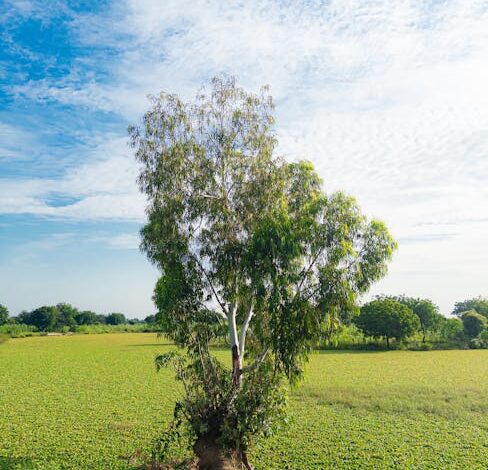The rise of algorithmic agriculture? AI steps in.

The rise of algorithmic agriculture? AI steps in.
Estimated reading time: 7 minutes
- AI is revolutionizing agriculture by optimizing resource allocation, improving crop selection, and enhancing overall farm productivity to address global food security challenges.
- Companies like Syngenta Vegetable Seeds and Heritable Agriculture are collaborating to use AI for precision seed selection, analyzing vast datasets to recommend optimal varieties down to a 10-meter accuracy.
- AI streamlines the traditional, labor-intensive process of seed selection, saving significant time and resources while boosting yields and ensuring crops thrive in specific micro-climates.
- Embracing algorithmic agriculture requires strategic steps including investing in robust data infrastructure, piloting AI solutions, fostering collaborations, and committing to continuous learning and adaptation.
- The ultimate goal is to build a more secure, resilient, and sustainable food system, making food affordable, reliable, and robust against climate change by optimizing resource use and minimizing waste.
Introduction to Algorithmic Agriculture
The global agricultural landscape stands at a critical juncture. Faced with the dual pressures of feeding an ever-growing population and navigating the unpredictability of climate change, the industry is increasingly turning to innovative solutions. Among these, Artificial Intelligence (AI) is emerging as a powerful catalyst, transforming traditional farming practices and promising a future of smarter, more resilient food production. From optimizing resource allocation to revolutionizing crop selection, AI’s potential in agriculture is profound.
AI is the cream of the crop in today’s tech field, with industries relying on generative AI to improve operations and boost productivity. One sector that is using AI with measurable results is agriculture, with vegetable seed companies harnessing the technology to identify the best vegetable varieties out of thousands of options. This facility can help growers in diverse markets who work in very different conditions from one another.
Finding the best vegetable seeds is not just down to yield – growers look for varieties that address unique local climate patterns and growing conditions. The traditional route of variety selection involves several manual processes, including testing and comparing different seed varieties, running field trials, mass data collection, and gathering feedback from growers. Now, seed companies are now turning to AI technology that run alongside traditional selection methods, to analyse such information. This saves time and resources between selection and first crop.
Syngenta Vegetable Seeds and Heritable Agriculture are at the forefront of AI adoption in this sector, and are collaborating to enhance commercial crop portfolios. Heritable is a new company spun out of the innovation lab at Alphabet (Google’s parent company) that develops AI tools to analyse agricultural data. The two companies combine to create software systems that can recommend which vegetable seed varieties should be offered to which growers and where.
Using AI tools with Syngenta’s global product portfolio, Heritable relies on crop trialling and existing data on localised geographical conditions to predict the best-performing commercial seed varieties for different regions. The aim is to forecast how well vegetable seed varieties will perform for growers worldwide yet on a micro-level, accurately predicting the best choices down to an accuracy of around 10 metres x 10 metres.
Matthew Johnston, Global Head of Vegetable Seeds and Flowers at Syngenta, said AI has considerable potential in agriculture. “Planting the right seed is important to a grower’s success. New technologies like AI can help us bring the best innovation to the field or greenhouse.”
Syngenta has already been using AI in its business, in areas like bio-stimulant and fertiliser development. Recently, the company added an AI chatbot called ‘Cropwise AI’ to its Cropwise digital platform to help growers make informed decisions about crop choices by analysing data.
Ultimately, the goal is to improve food security and ensure growers around the world can produce food that is affordable, resilient, and reliable. That’s particularly important as climate conditions change and become more unpredictable.

Beyond the Field: AI’s Role in Precision Seed Selection
The traditional process of selecting the ideal vegetable seed variety has long been a labor-intensive endeavor, often relying on extensive field trials, manual data collection, and accumulated grower experience. While invaluable, this approach can be slow and resource-heavy, delaying the introduction of superior varieties to market. AI is now stepping in to augment these methods, providing unparalleled analytical capabilities that streamline decision-making for vegetable seed companies.
AI algorithms can rapidly process vast datasets, including historical yield data, soil composition, weather patterns, and genetic markers, to identify the most suitable seed varieties for specific micro-climates and growing conditions. This level of precision moves beyond general regional recommendations, allowing for tailored advice that considers factors down to an astounding 10 square meters. Such granular insights enable growers to make informed choices that maximize their potential for success, ensuring crops thrive in their unique environments and meet diverse market demands.
By shortening the gap between seed selection and the first successful harvest, AI not only saves significant time and resources but also significantly boosts productivity. This efficiency translates into economic benefits for growers and contributes to a more stable and profitable agricultural sector overall. The ability to predict performance with such accuracy marks a paradigm shift, moving agriculture from reactive responses to proactive, data-driven strategies.
Syngenta & Heritable: Cultivating Future Harvests with AI
The collaboration between Syngenta Vegetable Seeds and Heritable Agriculture stands as a prime example of AI’s transformative power in action. This partnership leverages Syngenta’s extensive global product portfolio and deep agricultural expertise with Heritable’s cutting-edge AI tools, developed from Alphabet’s innovation lab. Together, they are crafting sophisticated software systems that can precisely recommend which vegetable seed varieties are best suited for particular growers and their specific geographical locations.
Heritable’s AI, fed with Syngenta’s crop trial data and localized geographical information, predicts the optimal commercial seed varieties. This goes beyond simple yield potential, factoring in resilience to local pests, diseases, and climate fluctuations. The commitment to forecasting performance at a micro-level, with an accuracy of approximately 10 metres x 10 metres, is a testament to the future of precision agriculture. As Matthew Johnston, Global Head of Vegetable Seeds and Flowers at Syngenta, rightly states, “Planting the right seed is important to a grower’s success. New technologies like AI can help us bring the best innovation to the field or greenhouse.”
Syngenta’s dedication to integrating AI extends beyond this partnership. The company has already successfully applied AI in areas such as bio-stimulant and fertiliser development. More recently, the introduction of ‘Cropwise AI’, an AI chatbot within its Cropwise digital platform, further empowers growers. This chatbot provides data-driven recommendations, helping them navigate complex decisions about crop choices and management, ultimately leading to better outcomes in the field or greenhouse.
Actionable Steps for Embracing Algorithmic Agriculture
For organizations and individuals looking to harness the power of AI in agriculture, taking strategic, deliberate steps is crucial. The journey into algorithmic agriculture requires a blend of technological adoption and a willingness to innovate.
-
Invest in Data Infrastructure and Collection: The foundation of any effective AI system is robust, high-quality data. Growers, seed companies, and agricultural tech providers must prioritize collecting comprehensive data on soil conditions, weather patterns, historical crop performance, pest outbreaks, and genetic traits. Implementing sensors, drones, and digital platforms for efficient data capture and storage is a critical first step. Clean, organized, and accessible data is paramount for training accurate AI models.
-
Pilot AI Solutions and Foster Collaboration: Start small with pilot projects to test AI tools in specific areas, such as seed selection for a particular crop or optimizing irrigation in a defined plot. This allows for learning and refinement without widespread risk. Crucially, seek partnerships with AI development firms like Heritable Agriculture or agricultural tech companies. Collaborating can provide access to specialized AI expertise, advanced algorithms, and proven solutions, accelerating the integration process and leveraging collective knowledge.
-
Prioritize Continuous Learning and Adaptation: The agricultural landscape is dynamic, with climate patterns shifting and new challenges emerging. AI models are not static; they require continuous learning and refinement. Establish mechanisms for feeding new data back into the system, updating algorithms, and adapting to changing environmental conditions or market demands. Regular evaluation of AI’s performance and soliciting feedback from growers will ensure the technology remains relevant, accurate, and truly beneficial over time.
The Broader Impact: Securing Our Food Future
The ultimate vision behind the rise of algorithmic agriculture is profoundly significant: to build a more secure, resilient, and sustainable global food system. As climate conditions become increasingly volatile and unpredictable, the ability to make precise, data-driven decisions about crop selection and management becomes not just advantageous, but essential. AI empowers growers worldwide to produce food that is not only affordable and reliable but also robust enough to withstand environmental pressures.
By optimizing the use of land, water, and other vital resources, AI contributes significantly to environmental sustainability. It minimizes waste, reduces the need for excessive chemical inputs through targeted applications, and enhances overall farm productivity without overburdening natural ecosystems. This intelligent approach to agriculture holds the key to addressing critical global challenges, ensuring food security for future generations amidst a changing planet.
Conclusion
The integration of AI into agriculture represents a pivotal moment for the industry. From refining seed selection with unparalleled precision to informing critical farm management decisions, algorithmic agriculture is paving the way for a smarter, more efficient, and incredibly resilient food production system. Companies like Syngenta and Heritable are leading this charge, demonstrating the tangible benefits of harnessing advanced technology to meet the complex demands of modern farming. As we look ahead, AI’s role will only grow, transforming challenges into opportunities and cultivating a future where global food security is not just an aspiration, but a predictable reality.
Want to learn more about AI and big data from industry leaders? Check out AI & Big Data Expo taking place in Amsterdam, California, and London. The comprehensive event is part of TechEx and co-located with other leading technology events. Click here for more information.
AI News is powered by TechForge Media. Explore other upcoming enterprise technology events and webinars here.
The post The rise of algorithmic agriculture? AI steps in appeared first on AI News.
Frequently Asked Questions
Q1: What is algorithmic agriculture?
Algorithmic agriculture refers to the application of Artificial Intelligence (AI) and other advanced computing techniques to optimize various aspects of farming. This includes using AI for precision seed selection, resource management, crop monitoring, yield prediction, and developing strategies to mitigate the impacts of climate change on food production.
Q2: How does AI improve seed selection?
AI improves seed selection by analyzing vast datasets, including historical yield data, soil composition, localized weather patterns, and genetic markers. This allows algorithms to identify the most suitable seed varieties for specific micro-climates and growing conditions with high precision (e.g., down to 10 square meters), significantly shortening the time from selection to successful harvest.
Q3: What companies are leading in AI agriculture, specifically in seed selection?
Syngenta Vegetable Seeds and Heritable Agriculture are prominent leaders in applying AI to seed selection. Their collaboration leverages Syngenta’s global product portfolio and Heritable’s AI tools (developed from Alphabet’s innovation lab) to create software systems that recommend optimal vegetable seed varieties for specific growers and geographical locations.
Q4: What are the broader benefits of AI in agriculture?
Beyond seed selection, AI in agriculture contributes to food security by enabling more affordable, resilient, and reliable food production. It promotes environmental sustainability by optimizing land and water use, minimizing waste, and reducing the need for excessive chemical inputs, ultimately building a more sustainable global food system capable of withstanding climate change.
Q5: How can growers start using AI in their operations?
Growers can begin by investing in data infrastructure and collection, utilizing sensors and digital platforms for comprehensive data. It’s advisable to pilot AI solutions on a small scale, seek collaborations with AI development firms or agricultural tech companies, and prioritize continuous learning and adaptation to ensure the technology remains relevant and beneficial.





